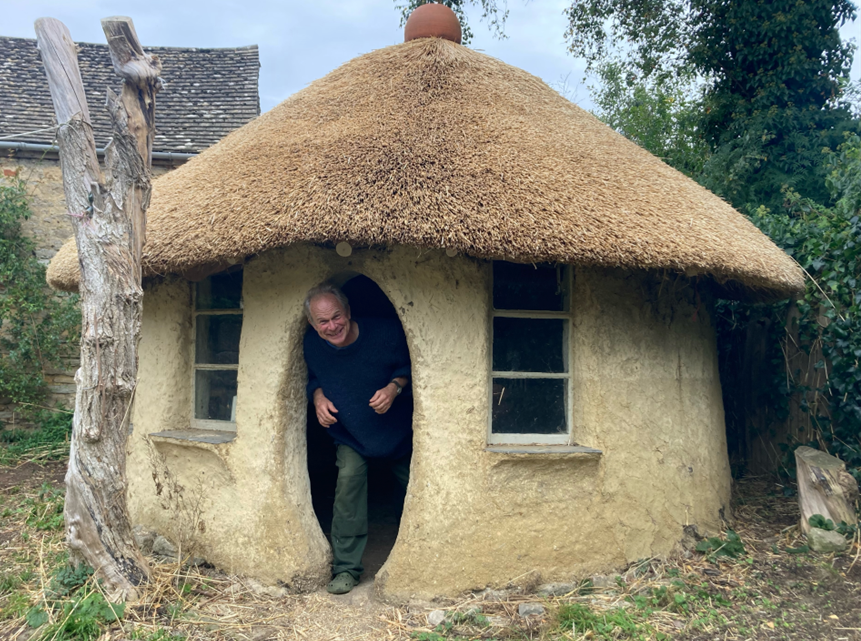Our Hidden Gems – Mike Buck
25 November 2023When I arrive at his Godstow Road house, Michael Buck is brimming with excitement. “I know it’s showing off, but I’ve just got to show you something!” he says. He leads the way through his house – rooms in dark plummy shades, well-loved furniture, oil paintings hanging on the shadowy walls – through to his back-garden. A fairy-tale well stands to one side. Michael ushers me around the corner of the L-shaped garden and there it is: a house fit for a hobbit, not a straight line in sight, with quirky tear-drop windows. “We’ve just re-thatched the roof!” he erupts joyfully.
For me, this unexpected treasure is the perfect start to the interview. I had always been intrigued by this sunny man. For years, I had seen him: herding community-owned geese on Wolvercote commons, carrying a metal (never a plastic) bucket, cutting Wolvercote Green with an old-fashioned scythe and fashioning the hay into haystacks which resemble Monet paintings. His smile was always glorious. I knew that Michael had been Chair of the Commoners, and a Green Party county councillor, and had helped spearhead the community farm and Low Carbon Wolvercote. But I was curious to know what inspires him to live the way he does – free of the mobile phone and Amazon addictions that afflict most of us – and why he always looks so delightfully happy. In his rustic kitchen, he tells me his story.
Raised in Buckinghamshire, Michael connected deeply with nature during frequent jaunts in the Chilterns. He also loved helping during the harvest at his granddad’s farm in Lincolnshire. “We used to ride in the grain cart and shoot at each other with peashooters. Granddad used to build this huge stack of bales on a sleigh as they came out of the baler. He’d get me to stand on top and sort of pivot it, so it didn’t collapse when he pushed the pile off the sleigh. It was thrilling for a kid.”
A turning point came when Michael was nineteen and went with his future wife, Sheila, to live at Findhorn eco-village in Scotland. It was 1973, and the eco-movement was in its early infancy. Later, Findhorn would become one of the biggest eco-villages in the world. “It is impossible to explain to how transformational and high-energy it felt. We all had to work incredibly hard to build the community up. It was all based on connecting people with nature through the landscape – building using local materials. Working with nature, not against it. It sounds old-fashioned, but it was really cutting edge. This was when I realised that I wanted to be part of nature and working with other people in the same vein.”
After Findhorn, Michael sought to live a simple, natural life. He and the ever-supportive Sheila raised three children using only water pumped from their own well, and eating home-grown vegetables. Michael grazed cattle on the commons and built a compost toilet. The magical house in their garden is perhaps emblematic of his lifestyle. It is made of cob – a mix of straw, sand, and clay – which friends spent the day ‘poddling’ with their bare feet. “I always love building things with other people.” Nothing was purchased: windows were made from an old bus windscreen; the clay came from the garden; homegrown wheat was used for the thatch. “We threshed the wheat first and used it for making bread. We used to say, we ate our roof!” Now the cob house is used for communal meditation and solstice storytelling.
After years of teaching art at St Edward’s school (he has an art degree and is an accomplished painter), Michael spent a year working at North Aston Organic Farm. There he built a larger cob house, now inhabited, spending only £150. The idea was to show alternatives to “the madness of house prices.” He also was inspired to start ‘Meadowshare’ to encourage people to use Wolvercote Common. Forty people invested and helped raise geese and cattle. At Michaelmas, a feast was held in the Village Hall.
Michael is never preachy about the merits of his back-to-basics lifestyle – he’s too busy. But when I press him on why he eschews power tools and mod cons, he’s eloquent: “For me, work is love in action.” An example is scything: “The swish of the scythes is quiet and it’s not polluting. It connects you to the land. When a group of you in the morning (it’s best to do it when the dew is still on) get into a rhythm, there’s nothing like it.” It also builds community: “When we’re working, people come and chat and impart news. We were turning the hay one day, when a woman came down the hill on her bicycle. She slammed on her brakes and said, ‘What’s that wonderful smell!’”
As I leave, Michael and Sheila don’t waste much time on goodbyes. Their arms are already full of milk bottles that have been dropped off at their house by North Aston Organic Farm for collection by villagers. But Michael gives me his beautiful smile. He’s back to work. Back to “love in action.”



